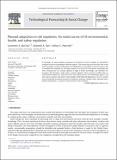Planned adaptation in risk regulation: An initial survey of US environmental, health, and safety regulation
Author(s)
Oye, Kenneth A.; McCray, Lawrence; Petersen, Arthur Caesar
DownloadMcCray-2010-Planned adaptation i.pdf (172.6Kb)
PUBLISHER_CC
Publisher with Creative Commons License
Creative Commons Attribution
Terms of use
Metadata
Show full item recordAbstract
In principle, we want regulatory programs to be based on current realities, as reflected for example in the best knowledge of relevant experts. That would imply that old rules now on the books should be consistent with today's knowledge base, not just what was known when a rule or standard was originally set. This paper reports on a survey of US programs, examining how often existing rules are actually updated in light of better knowledge, and identifies five programs that attempt to make policy routinely adaptive. These programs exhibit what we term Planned Adaptation: they both revise rules when relevant new knowledge appears, and take steps to produce such improved knowledge. While Planned Adaptation is rare, it is used in several nationally prominent programs, including air pollution, airplane safety, and drug safety. Planned Adaptation is a policy tool that deserves more attention.
Date issued
2010-02Department
Massachusetts Institute of Technology. Center for International Studies; Massachusetts Institute of Technology. Department of Political ScienceJournal
Technological Forecasting and Social Change
Publisher
Elsevier
Citation
McCray, Lawrence E., Kenneth A. Oye, and Arthur C. Petersen. “Planned Adaptation in Risk Regulation: An Initial Survey of US Environmental, Health, and Safety Regulation.” Technological Forecasting and Social Change 77, no. 6 (July 2010): 951–959.
Version: Final published version
ISSN
00401625